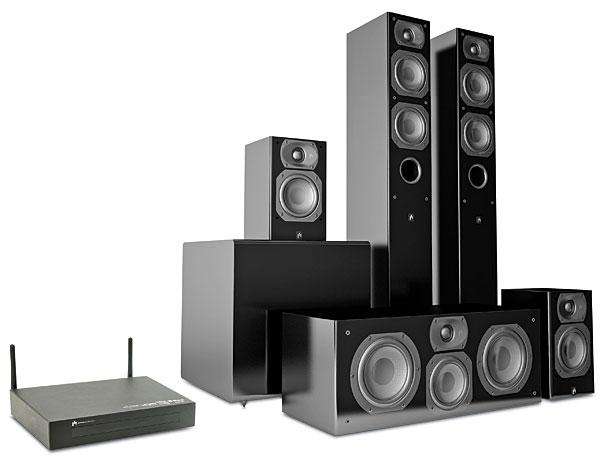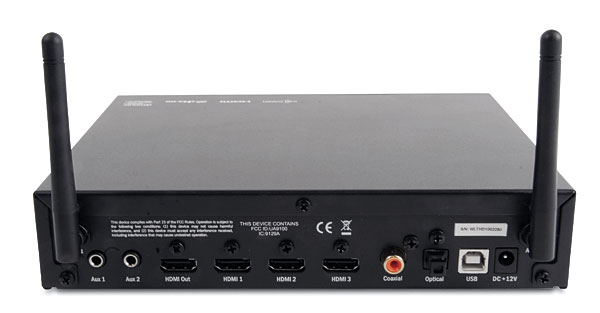Aperion Intimus 4T Summit Home Theater System

Not long ago, FedEx deposited a 7.1channel HTIB from Aperion Audio outside my door. It’s not really fair to call it a home theater in a box because the system actually comes in seven boxes and sells for $3,499. But since it includes source switching and amplification, it technically qualifies as an HTIB, albeit a rather unusual one. Aperion Audio prefers the term preconfigured home theater system. Normally, setting up this sort of home theater package would entail speaker wires crisscrossing the floor accompanied by the requisite grumbling, stripping of wires, and fumbling with speaker terminals. In this case, though, the Aperion speakers—a pair of towers, a center channel, a subwoofer, and two pair of satellite speakers—come out of their boxes, get placed in their appropriate spots in the room, have each one’s power cord plugged into the nearest AC outlet…and that’s it. OK, that’s not quite it. The system’s preamp transmitter also gets unboxed, plugged in, and has A/V sources connected to it. The important thing is that, despite the presence of eight speakers in the room, I haven’t used a single inch of speaker wire setting up Aperion Audio’s new Intimus 4T Summit wireless 7.1 system. But I’m so accustomed to jamming the ends of wire into terminals on the backs of speaker cabinets that setting up this system feels like the A/V equivalent of performing surgery and not suturing the incision after the operation is done. Fortunately, I’m unlikely to be sued for malpractice after the review is done.
Aperion Audio’s Intimus 4T Summit wireless 7.1 system consists of a pair of Intimus 4T Summit wireless powered tower speakers (I’m going to use SW for Summit Wireless), an Intimus 5C SW powered center speaker, two pair of Intimus 4B SW powered satellite speakers, a Bravus 8A SW powered subwoofer—all in a high-gloss black finish—along with the Home Theater One preamp transmitter. The 34inch-tall Intimus 4T SW twoway tower includes a 1-inch dome tweeter and two 4-inch low-frequency drivers in line above a port, all of which are hidden behind a black cloth grille. The 7.33-inch-tall Intimus 4B SW monitor speaker uses a similar 1-inch tweeter but includes only a single 4-inch woofer in a sealed cabinet. Both the tower and satellite speakers are internally biamped (120 watts total). The three-way, 19.33-inch-wide Intimus 5C SW center channel has a similar tweeter and 4inch driver, but adds an active 5.25-inch woofer plus a 5.25-inch passive radiator and is triamped (120 watts total). In addition to internal amps, each speaker includes its own DSP, digital crossovers, and DACs, as well as a built-in wireless receiver. There’s also a tiny, circular, special-purpose SpeakerFinder transducer hidden behind the grille on the front of each speaker’s cabinet, except for the center channel, which sports two transducers.
Wireless Wonder
What makes the wireless magic happen is the Home Theater One preamp transmitter. It has a relatively small chassis (2 x 8 x 7.5 inches) with two antennae attached to the back—if you didn’t know any better, you might think it was a large wireless router. But since it’s a preamp, the back also has three HDMI 1.4a ports, coaxial digital and optical digital inputs (one each), and two stereo analog 3.5mm inputs. On the front is a tiny display window that provides basic information, such as which input is selected, the surround format, and menu functions. The only video output is HDMI, which is just a passthrough to the HDTV. Video from component or composite video sources needs to be connected directly to the TV, with the digital or analog audio going to the Home Theater One’s audio inputs. The Home Theater One does not generate an onscreen display, which, depending on how far away you happen to sit from the Home Theater One, can make it difficult to see the device’s status or navigate the minimal menus. The system also includes a dedicated, non-universal IR remote control. While you can program the remote codes into a universal remote, the system’s remote includes a special MyZone transducer located at the front of the remote that’s absolutely necessary to use one of the amazing features of the system.

The Home Theater One can wirelessly broadcast up to eight channels of uncompressed 24-bit/48-kilohertz digital audio to the speakers simultaneously without perceivable transmission latency or dropouts. The system will convert from source material of up to 182-kHz sample rates to its native 48-Hz transmission format. This leads to an interesting (and somewhat misleading) designation in the Home Theater One’s specifications. While it’s certified to decode Dolby TrueHD lossless soundtracks, its official DTS designation is for DTS-HD, one step down from the lossess DTS-HD Master Audio format found on most Blu-rays today. In fact, Aperion confirmed that while the Home Theater One will indeed decode an HD Master lossless track from the disc, the required downconversion to 48 kHz prevents the official designation for DTS-HD Master Audio.
That said, this is still a huge leap in fidelity and number of channels over the typical wireless stereo products available today. Rather than develop its own proprietary system, Aperion chose to partner with Summit Semiconductor and use the company’s Summit Wireless Technology architecture, which the recently formed Wireless Speaker and Audio (WiSA) Association is working to promote as an interoperable wireless audio standard for the industry. If the idea spreads, in the future you should be able to mix, match, and upgrade WiSA-compliant speakers from different companies; and the possibility exists that the preamp transmitter circuitry could even be built into HDTVs or Blu-ray players.
Seek and Find
There are a number of things that make Summit Wireless Technology stand out. First, it uses the U-NII band, which extends from 5.1 gigahertz to 5.7 GHz to avoid interference from most of the other RF-generating devices using the 2.4-GHz and 5.8GHz bands. It supports up to 21 non-overlapping channels with strict rules that require devices to monitor and change channels if another device is transmitting on a particular channel. (I piled up a couple of wireless routers, my cell phone in hot spot mode with Bluetooth on, my iPad, my cordless phone, and ran the microwave, but I never could get so much as a burp from the system.) Second, 8 bits of forward error correction data are added to each 24-bit audio sample to help recover any data lost in transmission. This avoids the potential affects on latency and lip-synching that could be caused by having to retransmit data. In addition, each speaker supports up to 10 milliseconds of audio interpolation, so a huge loss of packet data won’t be audible; and, if more than 10 ms of packet data is lost, the speaker fades the volume to zero until the link is restored and then ramps the volume back up. Summit Semiconductor says this muting technique is very similar to the protocol used by CD and DVD players to handle scratches on discs.
There are two more unique parts of the Summit Wireless Technology. SpeakerFinder, for example, uses 40-kHz ultrasonic transducers built into the front of each speaker to automatically map the location of the individual speakers in the room. When the system is powered up, the master controller (in this case, the Aperion Home Theater One) tells the special-purpose transducer in each of the speakers to sequentially chirp ultrasonically, one after the other. Each speaker times how long it takes to hear the others and wirelessly relays the info back to the controller. Through the magic of mathematical algorithms, the controller calculates the distance between all of the speakers to within +/–2 inches; and based on its position in the room relative to the dedicated center channel, the controller assigns each speaker its proper audio channel (Left, Left Surround, Left Rear, etc.). Finally, the controller adjusts output levels and audio delays to compensate for location and distance relative to a guesstimated main listening position. (More about that in a minute.) Amazingly, the entire process only takes about two seconds. (You can also manually adjust your own speaker level settings—but not in two seconds.) Since the system maps the speaker locations each time it powers up, it will automatically reconfigure levels and delays if one or more speakers have been moved since the last time the system was powered up.
Summit Wireless Technology’s MyZone takes SpeakerFinder functionality one step further by using the MyZone transducer built into the system’s remote control to include the physical location of the listener into the calculations. Once the listener has decided to park his butt in a particular spot in the room, he holds the remote control at ear height and pushes the MyZone button. Approximately two seconds later, various volume, phase, and delay settings automatically adjust as necessary to acoustically move the sweet spot to that exact listening position (+/–2 inches). Summit Semiconductor says the technology is capable of adding up to 40 ms of delay for each speaker, which the company claims is sufficient to compensate for a 30 x 30–foot space—even in what Summit Semiconductor calls the worst case scenario of a listener choosing to sit next to a speaker in the corner of the room.
Seeing Is Relieving
There are a few particulars I didn’t mention previously about the setup of the system. One is that the fronts of all the speakers need to be able to see each other in order for SpeakerFinder to do its job. In other words, you can’t place a speaker—or the subwoofer—on the floor behind a couch. Another particular is that all of the speakers in the system have to be (at least slightly and however far apart) farther into the room than the Intimus 5C SW center channel. While this is typically the case with most LCR arrangements, it does limit the potential places where you can set the Bravus 8A SW subwoofer in the room. With all the speakers in position, you power up the Home Theater One, press the Associate button on the speaker closest to the subwoofer, and press Enter on the remote. That’s it, and unless you radically move your speakers in the room, you only have to do this once.





























































